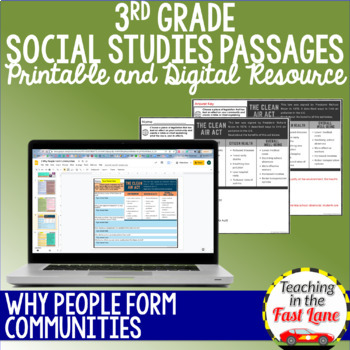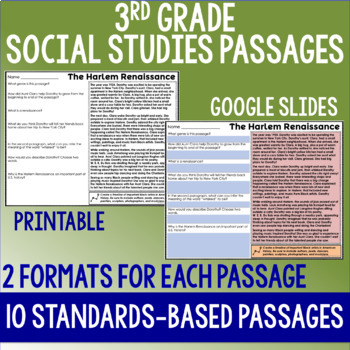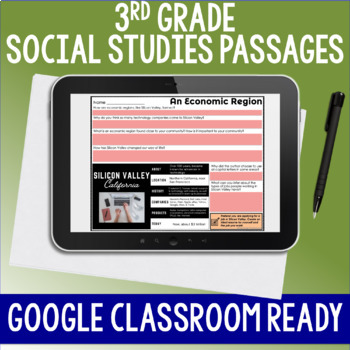Forming Communities - 3rd Grade Social Studies Reading Comprehension Passages
- PDF
- Google Apps™

Also included in
- It can be tough to find resources for 3rd grade social studies, but with these passages, you and your students will be ready to dive in! Check out this set of ten standards-based passages to integrate important social studies ideas into your ELAR block! These passages and questions were created to hPrice $39.95Original Price $100.00Save $60.05
Description
Are you looking for a way to teach your students about why people form communities? Check out this set of ten standards-based passages to integrate important social studies ideas into your ELAR block!
These passages and questions were created to help you integrate 3rd grade social studies into reading. I know classrooms are short on time, and this resource will give you twice the learning!
Each passage and set of questions takes up a single page and includes an optional extension activity for further learning. The topic of each passage was chosen to meet the streamlined social studies TEKS for 3rd grade. Multiple genres are used including fiction, expository, poetry, diary entries, biographies, infographics, graphic organizers, and maps.
These passages could be completed together in a small group setting, individually, or used for a station or center activity. The possibilities are endless!
This resource has both printable and digital formats to meet the needs of all classrooms and includes an answer key.
Included in this set of passages:
- A Quaker's Diary Entry
- Constitutional Convention Help Wanted Poster
- Economic Region Informational Website
- Cultural Community Travel Guide Entry
- New Amsterdam Expository
- Detroit Infographic
- Harlem Renaissance Historical Fiction
- Miami's Cuban Community Interview
- The Clean Air Act Chart
- New Echota Expository
➡️Please view the preview for a more complete look at the resource.
The Social Studies TEKS covered in this resource include:
3.2 The student understands common characteristics of communities, past and present. The student is expected to identify reasons people have formed communities, including a need for security and laws, religious freedom, and material well-being.
______________________________________________
More 3rd Grade Social Studies Passages?
- How Individuals and Events Influence Communities
- Why People Form Communities
- How Communities Meet Their Needs
- Physical Environments of Communities
- Adapting and Modifying Our Communities
- Humans' Effects on the Physical Environment
- Map Skills
- Money and Budgeting
- The Free Enterprise System
- Entrepreneurship
- Government
- Historical Documents
- Good Citizenship
- Civic Responsibility
- Community Culture
- Heroes in the Community
- Artists in the Community
- Scientists and Inventors
- Technology
- Celebrate Freedom
Want all the 3rd Grade Social Studies Passages? Check out the bundle to save!
______________________________________________
Looking for Texas History Passage Sets?
Looking for U.S. History Passage Sets?
Copyright 2022 Teaching in the Fast Lane LLC. All rights reserved by the author. Permission to copy and upload for a single classroom teacher only. Not for public display.
Do NOT place this resource on the open web or in a district shared drive. Do NOT share this resource with others without purchasing an additional license.
Please DO respect the work I put into this resource and do not share it with others.






